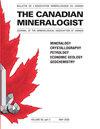用水热金刚石砧池原位观察绿柱石和酚醛矿在水溶液中的转变
IF 1.5
4区 地球科学
Q3 MINERALOGY
引用次数: 2
摘要
绿柱石和酚醛矿是重要的工业铍矿物。在BeO-Al2O3-SiO2-H2O (BASH)体系的水熔体中,采用淬火型高温高压设备进行的实验表明,Al2O3和SiO2 (αAl2O3和αSiO2)活性的不同是导致铍矿物组合不同的主要因素。在本研究中,我们尝试使用水热金刚石砧池原位观察酚醛土和绿柱石在BASH体系水溶液中的结晶过程。实验结果表明,在这种状态下(即长度为2.93 ~ 0.58 × 10−5 cm/s,体积为22.39 ~ 3.23 μm3/s), phenakite和绿柱石的结晶速度比在水熔体中更快。此外,在phenakite和beryl的结晶过程中,压力-温度条件分别大于467℃和220 MPa, 495℃和221 MPa,其最高温度和压力达到845℃和870℃,500 ~ 1300 MPa。这些特征表明温度不是控制BASH体系中酚醛土和绿柱石稳定性的主要因素。这种稳定性可归因于在加热和冷却过程中改变αSiO2和αAl2O3的组分在水溶液中的扩散。加热过程中,αSiO2增加,绿柱石溶解,导致酚醛石结晶;在冷却过程中,αSiO2和αAl2O3足以使剩余的绿柱石再结晶。因此,在BASH系统的加热和冷却过程中,水溶液中phenakite和绿柱石之间的转变可能不同。这一推理可以解释斑晶岩孔洞中丰富的斑晶矿,以及热液蚀变的伟晶岩、火山岩和其他富铍岩石中出现的斑晶矿,而不是绿柱石。本文章由计算机程序翻译,如有差异,请以英文原文为准。
In situ observations of the transition between beryl and phenakite in aqueous solutions using a hydrothermal diamond-anvil cell
Beryl and phenakite are important industrial beryllium minerals. In the hydrous melt of the BeO–Al2O3–SiO2–H2O (BASH) system, experiments using quench-type high-temperature and high-pressure equipment have revealed that the different activities of Al2O3 and SiO2 (αAl2O3 and αSiO2) are the main factors that lead to different beryllium mineral assemblages. In this study, we attempted in situ observation of the crystallization process of phenakite and beryl in an aqueous solution of the BASH system using a hydrothermal diamond-anvil cell. Experimental results indicate that phenakite and beryl can crystallize faster in this regime (i.e., 2.93–0.58 × 10−5 cm/s in length and 22.39–3.23 μm3/s in volume) than from a hydrous melt. In addition, in the phenakite and beryl crystallization, pressure–temperature conditions were greater than 467 °C and 220 MPa and 495 °C and 221 MPa, respectively, and their upper temperatures and pressures attained 845–870 °C and 500–1300 MPa. These features indicate that temperature is not the main factor that controls the stability of phenakite and beryl in the BASH system. This stability can be attributed to the diffusion of components in aqueous solution that change αSiO2 and αAl2O3 during the heating and cooling processes. During heating, αSiO2 increases while beryl is dissolving, which leads to phenakite crystallization; during cooling, αSiO2 and αAl2O3 are sufficient for the remaining beryl to recrystallize. Therefore, the transition between phenakite and beryl in the aqueous solution in the BASH system may be different during heating and cooling processes. This reasoning can explain the abundance of phenakite in miarolitic cavities and the occurrence of phenakite, rather than beryl, in hydrothermally altered pegmatites, volcanic rocks, and other beryllium-rich rocks.
求助全文
通过发布文献求助,成功后即可免费获取论文全文。
去求助
来源期刊

Canadian Mineralogist
地学-矿物学
CiteScore
2.20
自引率
22.20%
发文量
45
审稿时长
4-8 weeks
期刊介绍:
Since 1962, The Canadian Mineralogist has published papers dealing with all aspects of mineralogy, crystallography, petrology, economic geology, geochemistry, and applied mineralogy.
 求助内容:
求助内容: 应助结果提醒方式:
应助结果提醒方式:


